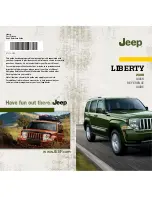
.
Do not drive or park over or near
flammable materials such as dry grass or
fallen leaves, as they may burn easily. The
exhaust system is very hot while the
engine is running and right after the
engine stops. This could create a fire
hazard.
Precautions when driving under espe-
cially dangerous situations:
.
If driving through water, such as when
crossing shallow streams, first check the
depth of the water and the bottom of the
stream bed for firmness and ensure that
the bed of the stream is flat. Drive slowly
and completely through the stream. The
water should be shallow enough that it
does not reach the vehicle
’
s undercar-
riage. Water entering the engine air intake
or the exhaust pipe or water splashing
onto electrical parts may damage your
vehicle and may cause it to stall. Never
attempt to drive through rushing water;
regardless of its depth, it can wash away
the ground from under your tires, resulting
in possible loss of traction and even
vehicle rollover.
.
If you must rock the vehicle to free it
from sand or mud, depress the accelerator
pedal slightly and move the select lever
back and forth between
“
D
”
and
“
R
”
repeatedly. Do not race the hybrid system.
For the best possible traction, avoid
spinning the wheels when trying to free
the vehicle.
&
After driving
.
Always check your brakes for effec-
tiveness immediately after driving in sand,
mud or water. Do this by driving slowly
and stepping on the brake pedal. Repeat
that process several times to dry out the
brake discs and brake pads.
.
After driving through tall grass, mud,
rocks, sand, rivers, etc., check that there
is no grass, bush, paper, rags, stones,
sand, etc. adhering to or trapped on the
underbody. Clear off any such matter from
the underbody. If the vehicle is used with
these materials trapped or adhering to the
underbody, a mechanical breakdown or
fire could occur.
.
Wash the vehicle
’
s underbody after off-
road driving. Suspension components are
particularly prone to dirt buildup, so they
need to be washed thoroughly.
Winter driving
&
Operation during cold
weather
!
Maintenance
Carry some emergency equipment, such
as a window scraper, a bag of sand,
flares, a small shovel and jumper cables.
Check the battery and cables. Cold
temperatures reduce battery capacity.
The battery must be in good condition to
provide enough power for cold winter
starts.
It normally takes longer to start the hybrid
system in very cold weather conditions.
Use an engine oil of a proper grade and
viscosity for cold weather. Using heavy
summer oil will make it harder to start the
hybrid system.
Keep the door locks from freezing by
squirting them with deicer or glycerin.
Forcing a frozen door open may damage
or separate the rubber weather strips
around the door. If the door is frozen,
use hot water to melt the ice, and after-
wards thoroughly wipe the water away.
Use a windshield washer fluid that con-
tains an antifreeze solution. Do not use
engine antifreeze or other substitutes
Driving tips/Winter driving
–
CONTINUED
–
8-7
Summary of Contents for CROSSTREK HYBRID 2016
Page 1: ...2016 Love It s what makes a Subaru a Subaru OWNER S MANUAL CROSSTREK HYBRID 8 17 15 3 09 PM...
Page 3: ...Vehicle types This manual describes the following vehicle types...
Page 21: ......
Page 103: ......
Page 137: ......
Page 233: ...Instruments and controls Horn Horn To sound the horn push the horn pad 3 96...
Page 403: ......
Page 443: ......
Page 513: ......
Page 531: ......
Page 532: ...Index 14...
Page 543: ......
Page 544: ......
















































